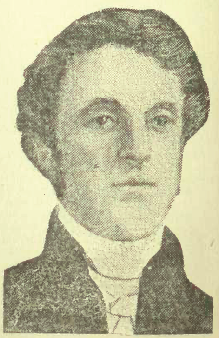Related Research Articles

The Province of Canada was a British colony in British North America from 1841 to 1867. Its formation reflected recommendations made by John Lambton, 1st Earl of Durham, in the Report on the Affairs of British North America following the Rebellions of 1837–1838.

John Neilson was a leading journalist, publisher and politician in Lower Canada. Born in Scotland, he emigrated to Lower Canada at age 15, to work for his older brother in his publishing company in Quebec City. On his brother's death, he acquired the business. Neilson became one of the leading publishers and booksellers in Lower Canada and in Upper Canada, in both French and English. He was the editor of the newspaper La Gazette de Québec/The Quebec Gazette.

The Attorney General of Ontario is the chief legal adviser to His Majesty the King in Right of Ontario and, by extension, the Government of Ontario. The Attorney General is a senior member of the Executive Council of Ontario and oversees the Ministry of the Attorney General – the department responsible for the oversight of the justice system in the province of Ontario. The Attorney General is an elected Member of Provincial Parliament who is appointed by the Lieutenant Governor of Ontario on the constitutional advice of the Premier of Ontario.

Sir Dominick Daly was a British colonial public servant and administrator during the 19th century, who held positions in British North America, Tobago and South Australia.

Henry Sherwood, was a lawyer and Tory politician in the Province of Canada. He was involved in provincial and municipal politics. Born into a Loyalist family in Brockville in Augusta Township, Upper Canada, he studied law and was called to the bar of Upper Canada in 1828. In 1838, he was appointed Queen's Counsel. Sherwood was part of the Family Compact, the inter-connected families of strong British and Loyalist sympathies which dominated the government of Upper Canada in the early years of the 19th century
The Legislative Assembly of the Province of Canada was the lower house of the legislature for the Province of Canada, which consisted of the former provinces of Lower Canada, then known as Canada East and later the province of Quebec, and Upper Canada, then known as Canada West and later the province of Ontario. It was created by The Union Act of 1840.

The First Parliament of the Province of Canada was summoned in 1841, following the union of Upper Canada and Lower Canada as the Province of Canada on February 10, 1841. The Parliament continued until dissolution in late 1844.
The 3rd Parliament of the Province of Canada was summoned in 1848, following the general election for the Legislative Assembly in January 1848. The first session was held at Montreal, Canada East. In 1849, rioters protesting the Rebellion Losses Bill burned the parliament buildings. The remaining sessions were held in Toronto. The Parliament was dissolved on November 6, 1851.
The 8th Parliament of the Province of Canada was summoned in August 1863, following the general election for the Legislative Assembly in August 1863. The Parliament was abolished when the British North America Act, 1867 came into force on July 1, 1867, creating the new country of Canada.
The Legislative Council of the Province of Canada was the upper house for the Province of Canada, which consisted of the former provinces of Lower Canada, then known as Canada East and later the province of Quebec, and Upper Canada, then known as Canada West and later the province of Ontario. It was created by The Union Act of 1840. With the lower house, the Legislative Assembly of the Province of Canada, the two houses constituted the Parliament of the Province of Canada.

John Hillyard Cameron, was an Ontario lawyer, businessman and political figure. He was a Conservative Member of Parliament representing Peel from 1867 to 1872 and Cardwell from 1872 until his death.

Charles Dewey Day, was a lawyer, judge and political figure in Lower Canada / Canada East. He was a member of the Special Council of Lower Canada, which governed Lower Canada after the Lower Canada Rebellions in 1837 and 1838. He was elected to the first Legislative Assembly of the Province of Canada in 1841, but resigned in 1842 to accept an appointment to the Court of Queen's Bench of Lower Canada.
Louis-Michel Viger was a Quebec lawyer, businessman, seigneur and political figure.
Harmannus Smith was a physician, farmer and political figure in Upper Canada and then the Province of Canada. He represented Wentworth County in the Legislative Assembly of Upper Canada from 1834 to 1836 as a Reformer and then in the Legislative Assembly of the Province of Canada from 1841 to 1851. He served a six-year term in the Legislative Council of the Province of Canada, from 1858 to 1864.
Edmund Fuller Murney was a lawyer and political figure in Upper Canada. He represented Hastings in the Legislative Assembly of Upper Canada from 1836 to 1841 and in the Legislative Assembly of the Province of Canada from 1842 to 1848 and from 1852 to 1856 as a Conservative member.

The Parliament of the Province of Canada was the legislature for the Province of Canada, made up of the two regions of Canada West and Canada East.

Section 68 of the Constitution Act, 1867 is a provision of the Constitution of Canada relating to the seats of government of the four original provinces, New Brunswick, Nova Scotia, Ontario and Quebec.